Vikramashila
| विक्रमशिला | |
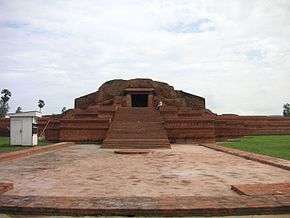 Ruins of Vikramashila Mahavihara | |
 Shown within Bihar | |
| Location | Bihar, India |
|---|---|
| Coordinates | 25°19′29″N 87°17′05″E / 25.32472°N 87.28472°ECoordinates: 25°19′29″N 87°17′05″E / 25.32472°N 87.28472°E |
| Type | Centre of learning |
| History | |
| Founded | 8th-9th century CE |
| Abandoned | 13th century CE |
| Events | Destroyed by Bakhtiyar Khilji around 1200 CE |
Vikramashila (IAST: Vikramaśilā) was one of the two most important centres of Buddhist learning in India during the Pala empire, along with Nalanda. Vikramashila was established by King Dharmapala (783 to 820) in response to a supposed decline in the quality of scholarship at Nalanda. Atisha, the renowned pandit, is sometimes listed as a notable abbot. It was destroyed by the forces of Muhammad bin Bakhtiyar Khilji around 1200.[1]
Vikramashila (village Antichak, district Bhagalpur, Bihar) is located at about 50 km east of Bhagalpur and about 13 km north-east of Kahalgaon, a railway station on Bhagalpur-Sahebganj section of Eastern Railway. It is approachable through 11 km long motorable road diverting from N.H.80 at Anadipur about 2 km from Kahalgaon.
History
A number of monasteries grew up during the Pāla period in ancient Bengal and Magadha. According to Tibetan sources, five great Mahaviharas stood out: Vikramashila, the premier university of the era; Nalanda, past its prime but still illustrious, Somapura, Odantapura, and Jagaddala.[2] The five monasteries formed a network; "all of them were under state supervision" and there existed "a system of co-ordination among them . . it seems from the evidence that the different seats of Buddhist learning that functioned in eastern India under the Pāla were regarded together as forming a network, an interlinked group of institutions," and it was common for great scholars to move easily from position to position among them.[3]
Vikramashila was founded by Pāla king Dharmapala in the late 8th or early 9th century. It prospered for about four centuries before it was destroyed by Bakhtiyar Khilji along with the other major centres of Buddhism in India around 1200.[4][5]
Vikramashila is known to us mainly through Tibetan sources, especially the writings of Tāranātha, the Tibetan monk historian of the 16th-17th centuries.[6]
Vikramashila was one of the largest Buddhist universities, with more than one hundred teachers and about one thousand students. It produced eminent scholars who were often invited by foreign countries to spread Buddhist learning, culture and religion. The most distinguished and eminent among all was Atiśh Dipankar, a founder of the Sarma traditions of Tibetan Buddhism. Subjects like philosophy, grammar, metaphysics, Indian logic etc. were taught here, but the most important branch of learning was tantrism.
Organisation
According to scholar Sukumar Dutt, Vikramashila appears to have had a more clearly delineated hierarchy than other mahaviharas, as follows:[7]
- Abbot (Adhyakṣa)
- Six gate protectors or gate scholars (Dvārapāla or Dvārapaṇḍita), one each for the Eastern, Western, First Central, Second Central, Northern, and Southern Gates
- Great Scholars (Mahapaṇḍita)
- Scholars (Paṇḍit), roughly 108 in number
- Professors or Teachers (Upādhyāya or Āchārya), roughly 160 in number including paṇḍits
- Resident monks (bhikhhu), roughly 1,000 in number
According to Tāranātha, at Vikramashila's peak during the reign of King Chanaka (955-83), the dvārapāla were as follows: Ratnākaraśānti (Eastern Gate), Vāgīsvarakīrti (Western Gate), Ratnavajra (First Central Gate), Jñānaśrīmitra (Second Central Gate), Naropa (Northern Gate), and Prajñākaramati (Southern Gate).[7] If this is correct, it must have been toward the end of Chanaka's reign given the generally accepted dates for Naropa (956-1041).
Tantric preceptors
Vikramaśīl was a centre for Vajrayana and employed Tantric preceptors. The first was Buddhajñānapād, followed by Dīpaṁkarabhadra and Jayabadhra.[8] The first two were active during Dharmapāl's reign, the third in the early to mid portion of the 9th century. Jayabadhra was the first prominent commentator on the Cakrasamvara tantra.[8] Śrīdhara was the next preceptor, followed by Bhavabhaṭṭa.[9] The latter, also a prominent commentator on Chakrasamvar, may have been the mahāsiddha Bhadrapād.[10] He in turn was succeed by three more prominent Chakrasamvar commentators, Bhavyakīrti, Durjayachandra, and Tathāgatarakhhit.[10] Durjayachandra collaborated with the renowned Tibetan translator Rinchen Zangpo (rin chen bzang po) and his commentary became particularly important for the Sakya school, and Tathāgatarakhhit collaborated with Rin-chen grags.[10]
In chronological order:
- Buddhajñānapād
- Dīpaṁkarabhadra
- Jayabadhra
- Śrīdhara
- Bhavabhaṭṭa
- Bhavyakīrti
- Līlavājra
- Durjaychandra
- Samayavajra
- Tathāgatarakhhit
- Bodhibhadra
- Kamalrakhhit
Curriculum
Vikramashila's curriculum taught formalized Vedic learning including Vedic texts, ritual, and the Vedāngas such as linguistics, reasoning, medicine, law, astronomy and city-planning.[11]
Layout and excavation
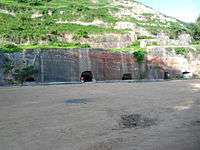
The remains of the ancient university have been partially excavated at village Antichak in the Bhagalpur district, Bihar state, India, and the process is still underway. Meticulous excavation at the site was conducted initially by B. P. Sinha of Patna University (1960–69) and subsequently by Archaeological Survey of India (1972–82). It has revealed a huge square monastery with a cruciform stupa in its centre, a library building and cluster of votive stupas.[12] To the north of monastery a number of scattered structures including a Tibetan and a Hindu temple have been found. The entire spread is over an area of more than one hundred acres.
The monastery, or residence for the Buddhist monks, is a huge square structure, each side measuring 330 metres having a series of 208 cells, 52 on each of the four sides opening into a common verandah. A few brick arched underground chambers beneath some of the cells have also been noticed which were probably meant for confined meditation by the monks.
The main stupa built for the purpose of worship is a brick structure laid in mud mortar which stands in the centre of the square monastery. This two-terraced stupa is cruciform on plan and about 15 metres high from the ground level accessible through a flight of steps on the north side. On each of the four cardinal directions there is a protruding chamber with a pillared antechamber and a separate pillared mandapa in front. In the four chambers of the stupa were placed colossal stucco images of seated Buddha of which three were found in situ but the remaining one on north side was possibly replaced by a stone image after the clay image was somehow damaged.
About 32 metres south of the monastery on its south west corner and attached with the main monastery through a narrow corridor is a rectangular structure identified as a library building. It was air-conditioned by cooled water of the adjoining reservoir through a range of vents in the back wall. The system was perhaps meant for preserving delicate manuscripts.
A large number of antiquities of different materials, unearthed from this place in the course of excavation, are displayed in the site museum maintained by the Archaeological Survey of India.
The Stupa
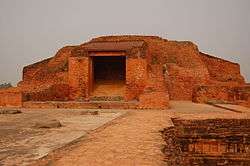
The Stupa is a sacred solid structure raised over the body remains or belongings of Buddha or a distinguished monk; or to commemorate any event associated with them. But some stupas are merely symbolic made for worship by the monks. A votive stupa is a miniature stupa erected by a devotee in gratitude of fulfillment of his desire.
The Vikramashila stupa built for the purpose of worship is a brick structure laid in mud mortar and stands in the centre of the square monastery. This two terraced stupa is cruciform on plan and about 15 metres high from the ground level. The lower terrace is about 2.25 metres high from the ground level and the upper terrace is at a similar height from the lower side. At both terraces there is a circumambulatory path, the lower about 4.5 metres wide and the upper about 3 metres wide.
The main stupa placed over the upper terrace is accessible through a flight of steps on the north side on each of the four cardinal directions. There is a protruding chamber with a pillared antechamber and a separate pillared mandapa in front, placed beyond the circumambulatory passage. In the four chambers of stupa were placed colossal stucco images of seated Buddha of which three were found in situ, but the remaining of the north side was possibly replaced by a stone image after the clay image was somehow damaged. All the stucco images are unfortunately broken above the waist. The images are placed over a brick pedestal having traces of painting in red and black pigments. The walls and floors of the chamber and antechamber were plastered with lime.
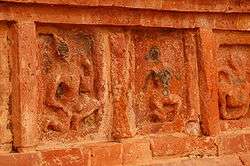
The walls of both the terraces are decorated with mouldings and terracotta plaques which testify the high excellence of terracotta art flourishing in the region during Pal period (8th to 12th centuries). The plaques depict many Buddhist deities like Buddha, Avalokiteshvara, Manjusri, Maitreya, Jambala, Marichi, and Tara, scenes related to Buddhism, some social and hunting scenes, and a few Nath deities like Adinath/Vishnu,Paddabati/ Parvati, Ardhanarisvara(Nath) and Hanuman(Nath) Many human figures, like those of ascetics, yogis(Nath), preachers, drummers, warriors, archers, snake charmers, etc., and animal figures like monkeys, elephants, horses, deer, boar, panthers, lions, wolves, and birds, are also depicted.
The architecture of the stupa and the terracotta plaques bear great resemblance to the Somapura Mahavihar, Paharpur (Bangladesh) which, too, was founded by the same king Dharmapala. In plan both are very much alike with the significant difference that Somapura is centred on a central temple rather than a stupa. Vikramashila monastery is also larger and has fort-like projections on its outer wall.
Restoration work
Vikramashila was neglected for years which contributed to extensive damages to the monument A.S.I. is now planning to develop the excavated site of Vikramashila.[6][13][14]
Since 2009, there has been considerable work in maintaining and beautifying the place to attract tourism. There has been inflow of western tourist as well, during their river cruises on the Ganga River.
Cultural activities
The Vikramashila site is the place for Vikramashila Mahotsav, which is held annually during the month of February.
How to reach there
The nearest big town is Kahalgaon about 13 km, It is approachable through 11 km long motorable road diverting from N.H. 80 at Anadipur, about 2 km from Kahalgaon.
Lately river cruises from Kolkata to Varanasi have started, which also stop by the Vikramashila ruins.[15]
In popular culture
An Indian Railways train recognizes this place by running a Train No. 2367/2368 Vikramashila Express that runs from Delhi to Bhagalpur, Bihar.
Gallery
- Ruins of Vikramashila
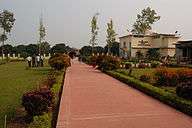 The Vikramashila Museum at the entrance of the Excavation site. It holds many exhibits which have been excavated from the ruins, these include monuments, art figures, utensils, coins, weapons and jewellery.
The Vikramashila Museum at the entrance of the Excavation site. It holds many exhibits which have been excavated from the ruins, these include monuments, art figures, utensils, coins, weapons and jewellery.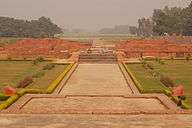 The view of the entrance from the Stupa.
The view of the entrance from the Stupa.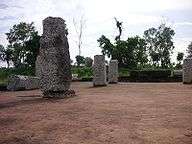 Pillars at Vikramashila University
Pillars at Vikramashila University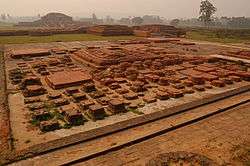 Landscape of Vikramashila Ruins, the seating and meditation area
Landscape of Vikramashila Ruins, the seating and meditation area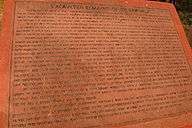 Vikramashila History on excavation location
Vikramashila History on excavation location Maintenance work going on to beautify the place
Maintenance work going on to beautify the place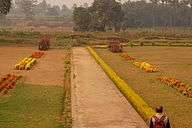 Gardens around the main stupa
Gardens around the main stupa A stone structure at the ruins
A stone structure at the ruins
See also
References
- ↑ Sanderson, Alexis. "The Śaiva Age: The Rise and Dominance of Śaivism during the Early Medieval Period." In: Genesis and Development of Tantrism,edited by Shingo Einoo. Tokyo: Institute of Oriental Culture, University of Tokyo, 2009. Institute of Oriental Culture Special Series, 23, pp. 89.
- ↑ Vajrayogini: Her Visualization, Rituals, and Forms by Elizabeth English. Wisdom Publications. ISBN 0-86171-329-X pg 15
- ↑ Buddhist Monks And Monasteries Of India: Their History And Contribution To Indian Culture. by Dutt, Sukumar. George Allen and Unwin Ltd, London 1962. pg 352-3
- ↑ . Khilji later moved to Bengal and fought with the Sena dynasty
- ↑ Scott, David (May 1995). "Buddhism and Islam: Past to Present Encounters and Interfaith Lessons". Numen. 42 (2): 141–155. doi:10.1163/1568527952598657. JSTOR 3270172.
- 1 2 "Excavated Remains at Nalanda". UNESCO World Heritage Centre. Retrieved 2012-07-13.
- 1 2 Buddhist Monks And Monasteries Of India: Their History And Contribution To Indian Culture. by Dutt, Sukumar. George Allen and Unwin Ltd, London 1962. pg 360-61
- 1 2 The Chakrasamvar Tantra (The Discourse of Śrī Heruka): A Study and Annotated Translation. by David B. Gray, Columbia University: 2007 pgs 11-12
- ↑ The Chakrasamvar Tantra (The Discourse of Śrī Heruka): A Study and Annotated Translation. by David B. Gray, Columbia University: 2007 pgs 21-22
- 1 2 3 The Chakrasamvar Tantra (The Discourse of Śrī Heruk): A Study and Annotated Translation. by David B. Gray, Columbia University: 2007 pg 12
- ↑ Frazier, Jessica (2011). The Continuum companion to Hindu studies. London: Continuum. p. 34. ISBN 978-0-8264-9966-0.
- ↑ Chaudhary, Pranava K (10 October 2009). "ASI to develop ancient site of Vikramshila Mahavihara". The Times of India.
- ↑ "Archive for Vikramshila University". Bihar-tourism.com. 2009-10-11. Retrieved 2012-07-13.
- ↑ Rajesh, Kumar (11 October 2009). "ASI team visits ancient Vikramshila varisty [sic] site". The Times of India.
- ↑ Chaudhary, Pranava K (28 November 2009). "River cruise boosts Bihar handicrafts sale". The Times of India.
External links
| Wikimedia Commons has media related to Vikramashila. |
- Archaeological Survey of India page for Vikramashila
-
 Bhagalpur travel guide from Wikivoyage
Bhagalpur travel guide from Wikivoyage